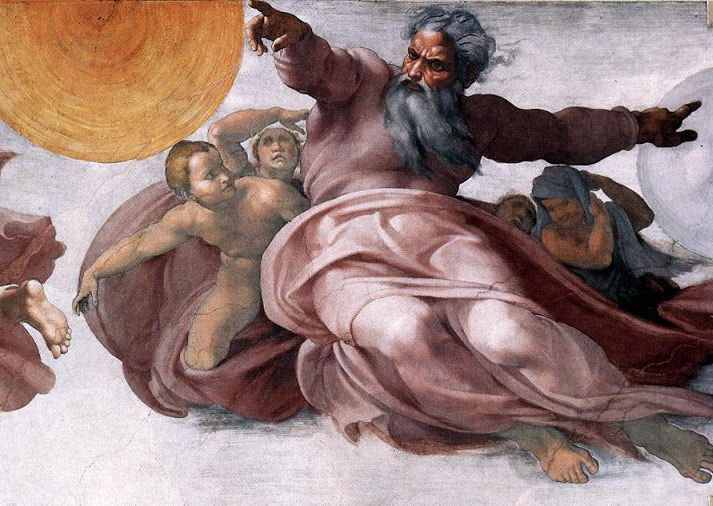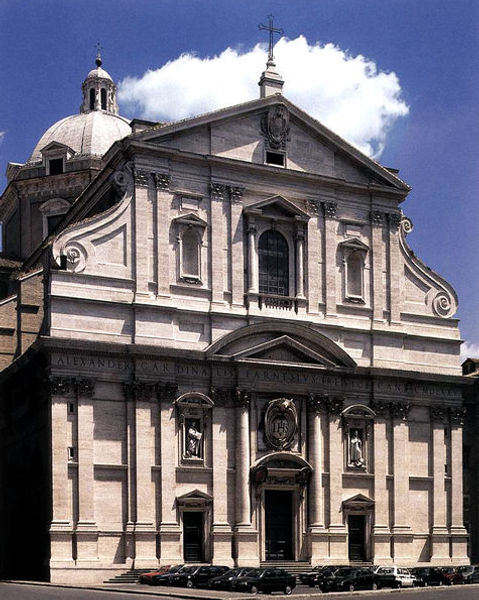<A>
Palestrina (his Improperia): *
In 1560 Palestrina (1525-1594) wrote an Improperia, using a simple setting for double choir; Pope Pius IV considered it so beautiful that he ordered it to be used in the Sixtine Chapel, where it is still sung on Good Friday each year.
sound file
<B>
Bach (his Cantatas): *
A cantata is a vocal work lasting about 20 minutes that comprises several smaller pieces with solo voice, chorus and instrumental accompaniment, sometimes all of these at once.
<C>
Giotto (caring and mild God):*
Baroncelli Polyptych (1334) Baroncelli Chapel, Santa Croce, Florence; Tempera on wood, 185 x 323 cm
Angels and saints have come together in a radiant assembly for the coronation of the Mother of God by her son. In the front rows kneeling angels make music, in those at the back the looks and gestures of those present are oriented towards the central event. The highly packed hosts of angels praising the Virgin & the huge figures in the central panel indicate that assistance was needed for this work. Giotto no longer worked with a few individual assistants, but now had a well-organized studio.

<D>
Lochner (caring and mild God): *
Last Judgement Triptych (1435-40) tempera on oak polyptych commissioned by the council of Cologne, one of his first works; the division of the wings into 6 distinct scenes reflects the medieval tradition & following many conventions of contemporary doom paintings, but Lochner introduces important innovations, especially in his rendering of the angel's black and flowing clothes. The small figures have a new freedom and move easily and with spirit & the human figure, nude or in profile, viewed from behind, or in movement, each detail rendered with equal attention.
The painting is divided into an upper & lower register, the upper dominated by the 3 large forms of Jesus, Mary and St. John. Jesus (dressed in a red robe decorated with pearls, revealing nail holes in his hands & a wound to his chest), is in the centre of the upper panel, sits on a double rainbow which emits beams, he looks down to the saved to his right. His right hand is raised blessing the dead to be admitted to Heaven, his left lowered to condemn the sinners to eternal punishment. Mary & John kneel at either side in poses of prayer begging for salvation for the souls beneath.

<E>
Michelangelo (Sistine Chapel):
ceiling Sistine Chapel frescos
The Separation of Light from Darkness, completed summer 1512 (last year of the project), 1st of 9 panels, scene from the Book of Genesis; at the centre God is shown in contrapposto rising into the sky, arms outstretched separating the light from the dark. Michelangelo employed sotto in su ("from below, upward"), making a figure appear rising above the viewer by using foreshortening.
The Creation of the Sun, Moon, and Planets, 1508 to 1512, 2nd of 9 panels; based on the biblical creation of the universe (Genesis 1:6-8); many symbols make a direct reference to the Bible; it displays a clear interpretation of the creation of the universe. God rushes thru the air with his of angels, arms extended in a cross-like shape (reflection of the future crucifixion); his face shows shadows heavier on the right side then the left & his body motion implies he is going away from the dark having just created the sun.


<F>
archetype of Il Gesu facade: *
the architect Della Porta derives aspects from St Peters: the paired pilasters & broken architrave of the lower story come from the exterior of St. Peter's. The upper story repeats the same pattern on a smaller scale with 4 instead of 6 pairs of supports; the difference in width is bridged by 2 scroll-shaped buttresses (a device borrowed from Michelangelo), forming a graceful transition to the large pediment crowning the façade. It retains the classic proportions of Renaissance architecture (the height equals the width). What is original is the integration of all the parts into one whole. Della Porta (freed from classicistic scruples by Michelangelo), gave the same vertical rhythm to both stories of the facade. This rhythm is obeyed by all the horizontal members (note the broken entablature), but the horizontal divisions in turn determine the size of the vertical members (hence no colossal order). Also note the emphasis on the main portal: its double frame, 2 pediments resting on coupled pilasters & columns, projects beyond the rest of the facade and gives strong focus to the entire design.

<G>
Della Porta (his cathedral facades): *
Santa Maria dei Monti, 1580, Rome, façade inspired by his prior work of the Church of the Gesù. It has two rows of Corinthian pilasters that are connected with volutes.

_-_facade_jp.jpg)
<H>
Maderna (his cathedral facades): *
first solo project façade for the ancient church of Santa Susanna (1597–1603); the structure is a dynamic rhythm of columns & pilasters, with a protruding central bay & condensed central decoration adding complexity to the structure; it reflects an incipient playfulness with the rules of classic design, still maintaining rigor; one of the first Baroque façades
<I>
Heinrich Schutz: *
(1585-1672) German composer & organist, regarded as the most important German composer before JS Bach, credited with bringing the Italian style to Germany and continuing its evolution from the Renaissance into the Early Baroque.
<J>
tone-worlds of 18th-Century church music: *